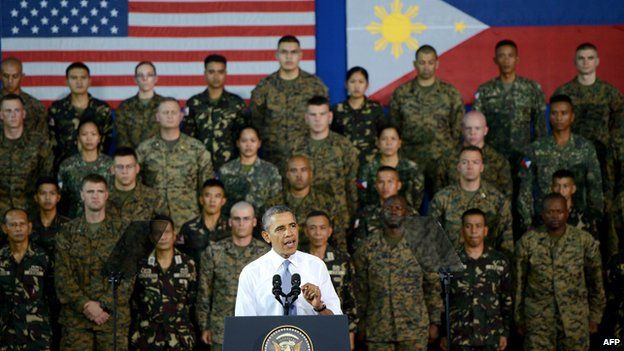8 Important Things You Need to Know About the EDCA
Jan 20, 2016 • Ian Benedict Mia

Jan 20, 2016 • Ian Benedict Mia

We’ve all heard news about the Enhanced Defense Cooperation Agreement (EDCA) being held by the Supreme Court as constitutional in a 10-4 vote, and one inhibition. There are people against it. For instance, many reacted to Pia Wurtzbach’s controversial answer on the EDCA, labeling her things like “traitor!”
Beyond the dissent of many people around social media, what exactly is this agreement, and where did it come from? Let this list be a guide for you to decide whether or not the EDCA can actually be beneficial in the long run.
The Philippines has become an important part of the U.S. military’s defense strategy since the United States (U.S.) acquired the Philippines after the Spanish-American War of 1898. In 1951 and 1998, the Mutual Defense Treaty and Philippines-United States Visiting Forces Agreement were signed, respectively. These two military agreements brought about joint activities between the two countries, which include the Balikatan.
However, it is said that the key driving force for the EDCA was the disaster response following the destruction caused by Typhoon Yolanda. Here, the U.S. military actively participated in assisting those who were affected by the tragedy. Considering how the U.S. is capable of assisting the defense, maritime security and humanitarian needs of the Philippines, the EDCA was then formed to address all these concerns.
To summarize, the EDCA covers four things: maritime security, joint military exercises, humanitarian assistance and disaster relief, and other activities as agreed upon by the two countries. In its initial term, the EDCA would last for ten years, unless terminated by the U.S. or Philippines. As for the military bases, the Philippine government is planning to provide 8 different bases where the U.S. military can build facilities and store equipment.
In its purest sense, the agreement seems to promise a land of milk and honey for our Filipino troops. However, we have to think about if this is actually a long-term solution for several problems, or simply a Band-aid solution. The latter seems to be more true, unfortunately. If the agreement eventually gets terminated, can we truly say that the Philippines can now stand on its own or will it forever be dependent on the U.S.?
One of the main purposes of the EDCA is to bolster the maritime defenses of the West Philippine Sea in case war erupts between the Philippines and China. Like what the U.S. has included in their defense strategy, they are committed and willing to assist other countries who are caught up in a similar situation. Remember the concept of a white man’s burden?
In the Middle East, the U.S. interfered with international affairs, and it did not turn out well. An increased U.S. military presence in the disputed territory could possibly bring more harm than good.
As promised in the agreement, U.S. military facilities constructed in the selected areas will become properties of the Philippine military. The joint military exercises between the two countries would also provide more knowledge and skills to Filipino troops, specifically in terms of combat, tactics, and handling advanced military equipment.
In addition to this, President Benigno Aquino III promised to spend the P83.9 billion budget for military modernization projects by 2017. The Philippine government has already spent around P56.79 billion to acquire military weapons such as jets, and to establish defense ties with other countries.
The much-awaited modernization of the Armed Forces of the Philippines may seem like a fairy tale at first glance, but considering the fact that the government is spending so much money on it, we might need time to rethink.
There are also U.S. military bases in Japan, South Korea, Taiwan, Thailand, and Singapore. Although Filipinos may think that we are the only ones involved in the U.S. military’s defense strategy, no, they have also established a military presence in several other countries. The usual reasons for establishing these bases would include “to allow interoperability of militaries” or “to establish strong relations.”
Despite how honorable and noble this may seem for the Americans, we should start asking ourselves why they tend to meddle in so many global affairs. Take for example the alleged power vacuum that was formed by the U.S. military in the Middle East, which inevitably led to the formation of the militant group ISIS.
According to the four justices who dismissed the EDCA as unconstitutional, the Philippines will indeed bolster its defenses but may end up losing its sovereignty because of the agreement. In the opening dissent of Associate Justice Marvic Leonen, he even said, “Para kayong mga birhen na naniniwala sa pag-ibig ng isang puta!”
If you heard that line before, go figure out why it was used in the context of EDCA. If you haven’t, you may want to find an opportunity to watch the film Heneral Luna by Jerrold Tarog.
Another dissenting opinion was that of Associate Justice Teresita Leonardo de Castro, who said, “While it is true that the Philippines cannot stand alone and will need friends within and beyond this region of the world, still we cannot offend our Constitution and bargain away our sovereignty.”
On the other hand, local surveys show that 90% of Filipinos welcome the continued presence of the U.S. military in the Asia Pacific region. There’s nothing new or surprising about these, because ever since the signing of the Mutual Defense Treaty and Philippines-United States Visiting Forces Agreement, Filipinos have been highly reliant with the U.S. in terms of military and humanitarian support.
However, when you think about it further, the U.S. has obviously included its own interests in the EDCA. It can all be related to the long history between the U.S. and Philippines. Most of the events that transpired between the two countries constitute heavily on satisfying the diplomatic strategy and self-interests of the U.S.
Now that China is imposing several navigational restrictions on the West Philippine Sea, the U.S. wants to interfere because they consider that area as “international waters.” This means that securing it as part of international waters would also secure their “pivotal” transition and reach to Southeast Asia. Furthermore, U.S. President Obama mentioned no specific agreement of protecting the Philippines against China.
War never changes, doesn’t it? Regardless of how you deal with war, whether it is psychological, logistical, or physical, it will only result to more suffering. Considering that the Philippines is still at the stage of dispute against China, let’s not make matters possibly escalate into a war by increasing U.S. military presence in the Philippines. However, that is just a personal opinion and there is really no guarantee of how these kinds of things would turn out.
In the meantime, we just have to keep informing ourselves about these issues.
Got something to add? Post your thoughts in the comments!
Input your search keywords and press Enter.
